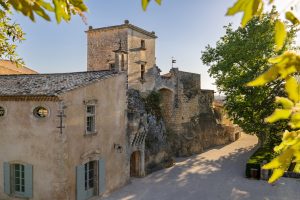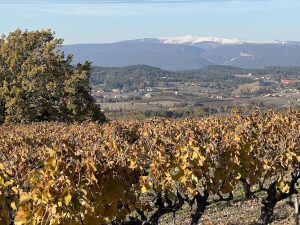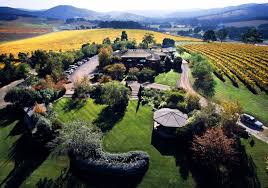Wine Hospitality Developing Around the World

Wine tasting and U.S.-style hospitality are gaining traction globally.
By Barbara Barrielle
Memorable experiences, or the lack of them, are key to winery tasting room visits in California, Oregon and Washington. Being able to taste wines and chat with winery representatives is something we take for granted in these regions. The better the experience, the better the sales for the winery. But how do other regions and countries approach winery hospitality? More and more, wineries around the globe are catering to visitors to enhance sales.
One of the many wine villages in the Tuscany region of Italy
Southern hospitality
Augusta, Missouri, became the first designated American Viticultural Area (AVA) in 1980 and, while probably not the best known wine region, the area continues to grow and thrive. It’s recently exploded in popularity due to an infusion of cash from billionaires such as Florida developer, David Hoffman, who have discovered the benefits of producing their own wines for their massive distribution outlets, including restaurants and convention centers. Hoffman is investing $100 million to turn Augusta into a national destination.
St. James Winery, one of the area’s originals, is now in its third generation of family ownership. Not only does it have a large tasting room featuring native and hybrid wine varieties that grow well in the AVA, but it’s built a brewery to attract beer drinkers. Brandon Hofherr, currently marketing director of the company, says, “Our founders, Jim and Pat Hofherr believed ‘Leave the world better than you found it,’ and that encompasses our approach to each and every person who walks through our door…. as well as sustainability and community.”
Something for everyone in the South of France

Renovated 13th century Chateau de Mille in the Luberon, France.
Across the Atlantic, in the traditional wine growing areas of France and Italy, hospitality has never been at the forefront of winery operations. Distribution to restaurants and direct to collectors was the way to go. But then mass production cooperatives started to export inexpensive wines heavily and wineries started to open their doors. Still, there remain historic wineries that don’t feel the need to welcome visitors — or that charge a hefty visitation fee.
In the Luberon region in the Southern Rhône Valley of France, new owners bought Chateau de Mille, a 13th century medieval castle and the oldest winery in the Luberon, and set about making it a perfect place for guests — young, old, adventurous or cerebral. Exploring the castle and grounds or enjoying the on-property art galleries and live music only adds to the wine experience.
“Hospitality is indeed at the heart of our approach at Château de Mille,” says vintner Constance Slaughter, a French native, who owns the winery with her American husband, Larry. “We offer private tours of the estate, including the vineyard, the château, the medieval chapel, the landscaped gardens, the viticulture museum and the private archive collection.” Tours conclude with a private tasting at the renovated 1907 winery or at the château.

Vineyards of Chateau de Mille
She continues, “After an enormous renovation project implemented by local artisans, we are delighted to share this incredible domain to the broader public. The aptésiens [locals] are happy to finally access this part of their local heritage and to share personal stories.” Guest villas invite visitors to stay a while for a full southern Rhône immersion.
Welcoming Guests, Italian-style
Another winery bringing upscale hospitality for the masses is in the Chianti region of Italy.
Il Molino di Grace is a spectacular property that hosted more than 12,000 visitors last year and sold 20% of its production through the tasting room. Staffed with knowledgeable guides that speak English, German, French and Spanish, tasting is not intimidating and everyone leaves with more wine savvy than they had before they arrived. After all, Italians are all about style.

Renovated 13th century Chateau de Mille in the Luberon, France.
“For us, the approach to hospitality is very important. In the last five years, we have invested money to create the best conditions to host people specially for wine tasting and tour in the vineyards,” says Winery Director Iacopo Morenti. “Our guests are excited to walk in the vineyards, taste the wines outside and also have something to eat.”
Il Molino di Grace oozes history in its hospitality, and art, which is very important to the
Grace family, can be jaw-dropping yet approachable. A farmhouse is available as an AirBnB in the vineyards dotted with outdoor sculpture among the rolling hills of Chianti.
In another region of Tuscany, Montalcino, most Brunello producers don’t have tasting rooms. Rather, wine bars for tasting are scattered around this charming town. Longtime producer Tommaso Cortonesi, of Cortonesi Montalcino Wines, will give an industry visitor a tour and tasting but relies on the very well-stocked Enoteca la Fortezza di Montalcino, with its highly educated staff, to introduce his 5,000-case production wine to the public.
Cellar Doors are open

Australia’s de Bortoli winery has several “cellar door” hospitality centers
Down under in Australia, tasting rooms are known by the charming name “cellar doors.” At DeBortoli Wines, a large producer of both fine wines and large export labels, hospitality is key at its cellar doors in the Yarra Valley, Bilbul, Hunter Valley and (the latest) Rutherglen. Cellar doors open to wine tasting and often have a restaurant. Wine is the star and the restaurant the supporting player.
Leeann De Bortoli explains, “all of our cellar doors are quite different because they’re located in quite different regions…we pride ourselves on providing warm, friendly hospitality to all visitors, reflecting our Italian heritage.
“Bilbul Cellar Door is the oldest cellar door — the mothership — where it all began back in 1928 when De Bortoli was founded by my grandfather. It’s also home to Noble One, one of Australia’s most iconic and highly-awarded dessert wines,” says DeBortoli.
“Before Covid, 50% of our visitors were from overseas and international travel has been a little slow to return but it is returning, spearheaded by Singapore and India, but we are now seeing American visitors coming through,” she says. “Experiential visitation is on the rise: our guests want to see the grapes on the vine, understand the process — be taken on a journey. Gone are the days when visitors would rock up at a cellar door and stand at the bar to taste [free] wine.”

DeBertoli Wines Yarra Valley
French Flair in Sonoma County
John Jordan, president of his namesake, Jordan Vineyards & Winery, likes to say, “We focus on three things: Chardonnay, Cabernet and hospitality. Hospitality is a pillar of who we are.”
With wine tasting experiences beginning at $80, Jordan is not inexpensive. As experiences become more complex and include seated food pairings, tours, and hikes, the price can escalate to $350 per guest for something like Jordan’s famous Parisian Pop-up Dinner. The winery has loyal fans and considers its audiences comprehensive “with a little something for everyone, from Gen Z and millennial guests who are new to wine country to long-time wine collectors in their 50s and 60s.”
Hospitality Becoming Key
Wine hospitality can take on many forms but, internationally, wine experiences are becoming important everywhere. Wine sold personally from a winery gains many things from an intimate connection with the brand and long-time customers to an enhanced bottom line.

